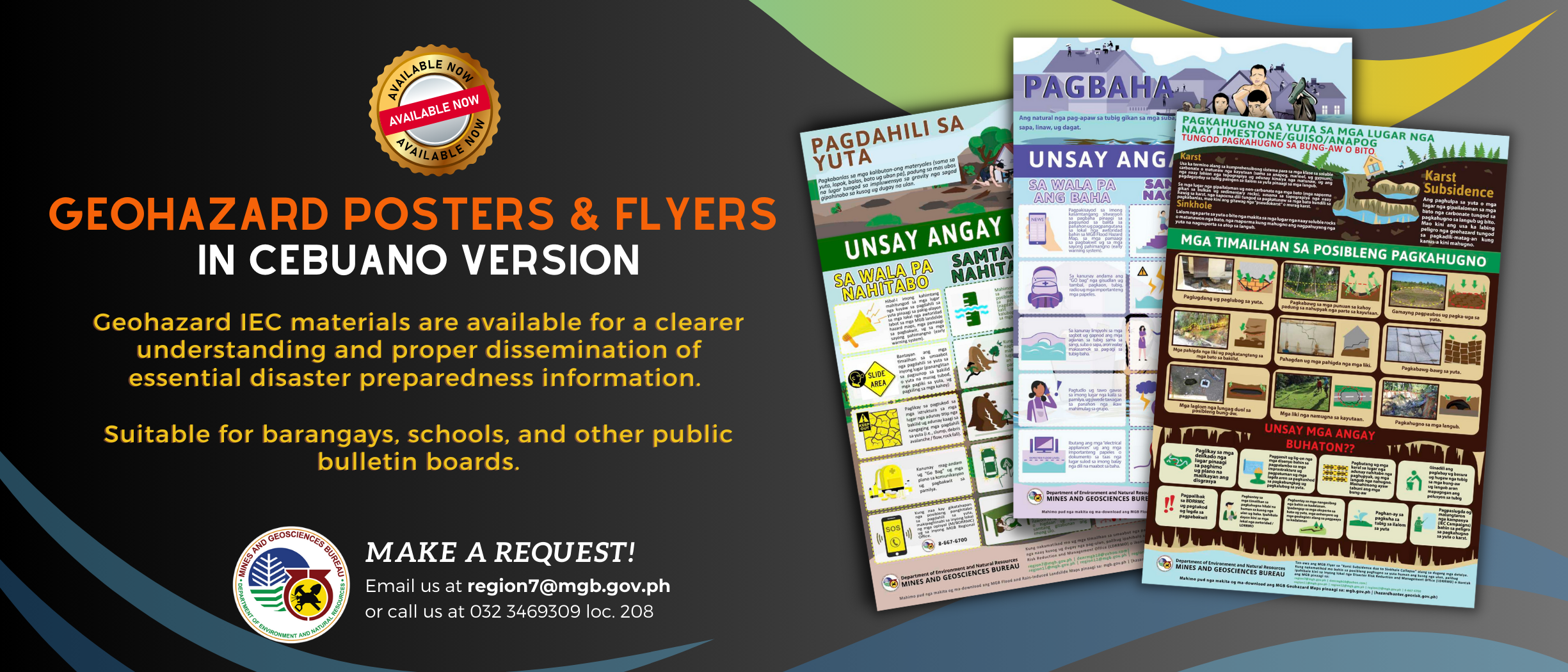The Department of Environment and Natural Resources (DENR), through its Mines and Geosciences Bureau (MGB) 7 has reiterated its advisory to all the communities who are living nearby or within a mountain or a hill and those along the riverbanks or creeks to be more cautious after heavy rains inundated a number of areas in Metro Cebu yesterday.
Taking a cue from a warning issued by the Philippine Atmospheric, Geophysical and Astronomical Services Administration (PAGASA) that a tropical storm “Mario” is expected to enter into the Philippine Area of Responsibility (PAR) by Friday, MGB 7 Regional Director Loreto B. Alburo issued anew geohazards threat advisories to all local chief executives to keep a close watch on the geohazards map on landslides and flood prone areas.
At 4:00 am today, Pagasa says “Mario” was estimated based on all available data at 460 km East of Catarman, Northern Samar (12.9ºN, 129.1ºE) with maximum sustained winds of 65 kph and gustiness of up to 80 kph. it is forecast to move west northwest at 28 kph.
Alburo said the local government units with the strong support from the communities themselves is the key towards achieving a “zero” casualty when disaster comes.
To facilitate easy access of the geohazards maps, the said maps in a 1-50,000-scale are now available and downloadable in four government websites, including that of a non-government organization.
The government websites hosting the interactive geohazard maps include that of the DENR (www.denr.gov.ph), Mines and Geosciences Bureau (www.mgb.gov.ph), Philippine Information Agency (www.pia.gov.ph) and that of Environmental Science for Social Change (www.essc.org.ph).
“It is very essential for mayors and barangay captains to give more attention of areas that are found to be highly susceptible to flooding and landslides within their areas of responsibility which have been known to them as MGB 7 already released a geohazards threat advisory,” said DENR 7 Regional Executive Director Dr. Isabelo R. Montejo.
Montejo also pushed for the local chief executives to appreciate the geohazard maps, and implement the necessary measures or interventions to lessen the impacts of landslides and flooding.
He warned that the volume of water brought by “Mario” might trigger soil conditions that have been either saturated by heavy rains.
Meanwhile, in Cebu City , 19 barangays are highly susceptible landslides, namely, Lusaran, Binaliw, Guba, Budlaan, Malubog, Buot-Taup, Busay, Sirao, Taptap, Tagbao, Tabunan, Pung-ol Sibugay,Sudlon II, Sudlon I, Sinsin, Buhisan, Pamutan, Sapangdaku, and Adlaon.
Barangays Tagjaguimit, Alpaco, Balirong, Mayana, Naalad, and Cogon in City of Naga.; Of the 28 barangays in Naga City, 17 barangays or 61 percent are critically or highly landslide and flood-prone; 11 barangays in Balamban: Hingatmonan, Lamesa, Luca, Ginatilan, Cabasiangan, Matun-og, Cansomoroy, Gaas, Magsaysay, Cabagdalan, and Duangan.
Five barangays in Toledo City : Tungkay, Pangamihan, Bagacay, Loay and Don Andres Soriano; Lamac in Pinamungahan; Five barangays in Asturias :Agbanga, Baye, Bairan, Kanluangan and Sak-sak.
All mountain barangays in Talisay City including Manipis; Brgy. Doldol, Purok 3 in Dumanjug; and Cansalonoy and Vivein Ronda.
In Bohol, those portions of those areas which have been affected by the 7.2 magnitude quake last year are advised to take the necessary precautions and to implement proactive evacuation are: Tagbilaran City, Baclayon, Corella, Cortes, Alburquerque, Panglao, Dauis, Loon, Calape, Catigbian, Balilihan, Batuan, Sagbayan, and Carmen.
Alburo said the assessment reveals that there are five barangays in Cebu City that are considered to be most hazardous to flooding and these are Kasambagan, Kinasang-an, Labangon, Mabolo, Bonbon, and Cebu City downtown areas and along the Guadalupe River; and seven barangays in Mandaue City to include Subangdaku, Mantuyong, Umapad, Opao, Alang-alang, Guizo, and Pakna-an.
In Negros Oriental, five barangays in Guihulngan City , namely, Humayhumay, Imelda, Mabunga, Sandayao, and Tacpao have high susceptibility to landslides. There are 12 barangays with moderate to high susceptibility to landslide and these are Bakid, Banwaque, Calamba, Calupa-an, Linantuyan, Mabunga, Maniak, Plagatasanon, Planas, Trinidad, Binobohan, and Villegas.
In La Libertad, nine barangays with high landslide susceptibility are Aniniaw, Aya, Biga-a, Guihob, Kansumandig, Mambutod, Managondong, Pangca, and Pitogo. Barangay Mandapaton has moderate to high susceptibility to landslide. Eleven barangays with moderate susceptibility to landslide are Manluminsag, Busilak, Cantopa, Elecia (Talostos), Eli, Manghulyawon, Martilo, Nasungon, San Jose, Solongon, and Tala-on.
Around nine barangays in Bayawan City , namely Banga, Maninihon, Poblacion, Villareal, Nangka, Suba, Ubos, Pagatban and Kalumbuyan are flood-prone areas.
Also in Siaton, barangays Poblacion II, Poblacion III, Poblacion IV, and San Jose were flood-prone areas; and barangays Calicugan, Maloh, Cabangahan, Giliga-on, Bonawan and Apoloy area landslides-prone areas.
In Basay, the flood-prone areas are barangays near Tyabanan, Pagatban, and Basay rivers.
A total of eight barangays in Dumaguete City are flood-prone areas, namely, Candau-ay, Cadawinonan, Tabuctubig, Batinguel, Poblacion, Junob, Poblacion 2, and Bagakay.
In Siquijor, six barangays have been assessed to be highly susceptible to landslides and flooding and these are Libo in Enrique Villanueva; Bintangan, and Helen, in Larena; and Cang-isad, Luyang, and Sabang, in Siquijor.






